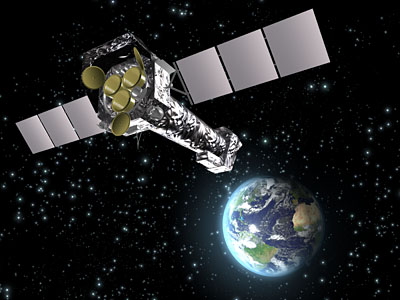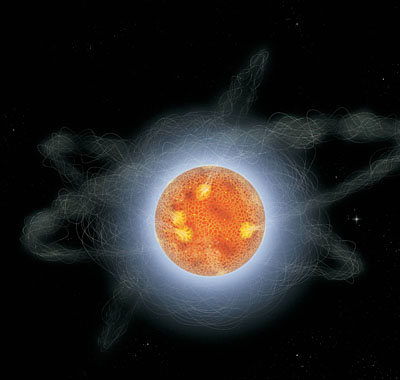[/caption]
Neutron stars are leftovers of massive stars (10-50 times as massive as our Sun) that have collapsed under their own weight. Most are only about 20 km in diameter, but they are so compact that a teaspoon of neutron star stuff would weigh about one hundred million tons. Two other physical properties characterize a neutron star: their fast rotation and strong magnetic field. Magnetars form a class of neutron stars with ultra-strong magnetic fields, approximately a thousand times stronger than that of ordinary neutron stars, making them the strongest known magnets in the cosmos. But astronomers have been unsure exactly why magnetars shine in X-rays. Data from ESA’s XMM-Newton and Integral orbiting observatories are being used to test, for the first time, the X-ray properties of magnetars.
So far, about 15 magnetars have been found. Five of them are known as soft gamma repeaters, or SGRs, because they sporadically release large, short bursts (lasting about 0.1 s) of low energy (soft) gamma rays and hard X-rays. The rest, about 10, are associated with anomalous X-ray pulsars, or AXPs. Although SGRs and AXPs were first thought to be different objects, we now know that they share many properties and that their activity is sustained by their strong magnetic fields.
Magnetars are different from ‘ordinary’ neutron stars because their internal magnetic field is thought to be strong enough to twist the stellar crust. Like in a circuit fed by a gigantic battery, this twist produces currents in the form of electron clouds which flow around the star. These currents interact with the radiation coming from the stellar surface, producing the X-rays.

Until now, scientists could not test their predictions, because it is not possible to produce such ultra-strong magnetic fields in laboratories on Earth.
To understand this phenomenon, a team led by Dr Nanda Rea from the University of Amsterdam used XMM-Newton and Integral data to search for these dense electron clouds around all known magnetars, for the first time.
Rea’s team found evidence that large electron currents do actually exist, and were able to measure the electron density which is a thousand times stronger than in a ‘normal’ pulsar. They have also measured the typical velocity at which the electron currents flow. With it, scientists have now established a link between an observed phenomenon and an actual physical process, an important clue in the puzzle of understanding these celestial objects.
The team is now working hard to develop and test more detailed models on the same line, to fully understand the behavior of matter under the influence of such strong magnetic fields.
Source: ESA


Eric near buffalo _Your crazy!!
Now to matter at hand.
If massive stars collapse into magnetars how big do the stars have to be to collapse into blackholes?
and if a magnetar and a black hole have so much mass are they in some way connected?
can one over time become the other?.
A teaspoon of neutron star matter would weigh 100 million tons? Wow.
How great would it be to trick some world class weight lifters with that?
“Your first task is to lift that teaspoon with the glowing material.”
“Ha…that’s a joke. ERGHHHHH! ERGHHHHHHHHHHHHHH!!! What the…? Is this thing glued to the table?”
“Ha…that’s a joke. ERGHHHHH! ERGHHHHHHHHHHHHHH!!! What the…? Is this thing glued to the table?”
Considering that it’s 100 million tons, it would have decimated the table. It should probably have been put on the ground. My bad.
Yeah, if a neutron star accretes enough material, then could collapse into a black hole. I don’t know what kind of radiation the event would produce.
If a neuron star has an electron cloud around it, couldn’t it be a giant model of an atom? 🙂
Assuming you could actually acquire a teaspoon of this substance… What would happen when it left the influence of the stars gravity?
Expand into a Rhode Island chunk of nuetrons?
Would it stay nuetrons?
If it is a neutron star, how could it have a magnetic field ? Aren’t they supposed to be related to electrons or particules with charge ?
@Eric: at 100 million tons per spoonful even solid rock wouldn’t hold it – it would simply bore it’s way through the crust!
@Ricardo: A neutron star is *mostly* neutrons and there’s a big difference between all neutrons and mostly neutrons.
@ No Astronomer: Very true. It would most likely leave a spoon shaped hole in the ground about 10 feet deep, maybe less – maybe more, depending on where the bedrock lies at any given location on the planet.
@ LLDIAZ: I’m not crazy, I just think a little differently 🙂
~~LLDIAZ Says:
November 14th, 2008 at 7:56 am
Now to matter at hand.
If massive stars collapse into magnetars how big do the stars have to be to collapse into blackholes?~~
Good question… and I can’t answer it. I can however speculate it may take a star the size of one reported a while back on here. If I recall correctly, there was a story on here about a star that was found semi-recently that possibly had the circumference of Saturn’s orbit. If that is correct from memory, that’s a bloody big star. Maybe that one would do the trick.
Is the shape of the magnetic field distorted by the gravity of the magnatar?
100 Million tons would be about 300 empire state building or 400 sears towers or 112 golden gate bridges. Or what? About all of the buildings in lower Manhattan?
@Sid, Yes, the magnetic field of a magnetar can easily be distorted by the gravity of a magnetar, and vice versa. Starquakes (rearrangement of the neutron star matter) can greatly modify the magnetic field of a magnetar, producing prodigous amounts of electromagnetic radiation in the process. Rapid fluctuations in the magnetic field of a magnetar can also generated enormous amounts of EM radiation from this compact object.. The key to both of these processes lies in the extreme density of the neutron star and the enormous strength of the magnetic fields involved in a magnetar. And just because a neutron star may present a neutral magnetic moment from the magnetar, the already established intense magnetic field of the magnetar does not just disappear spontaneously. These extreme objects are sure to undergo intense scrutiny in coming years by astronomers and physicists involved in (extreme) condensed matter physics.
Okay, some answers from a semi-expert…
@Eric Near Buffalo and his idea: Actually, it would tunnel right though to the Earth’s core and almost up to the other side again before swinging back. 100 million tons placed on a surface of a few square inches?? That creates a pressure which penetrates anything! Even bedrock, mantle rock etc. But…
…this leads us to a comment for dbdncr:
Neutronium has both an upper and a lower mass limit.
Concerning the upper mass limit and one question from LLDIAZ: There’s a mass named the Tolman-Oppenheimer-Volkov mass which is the neutron star version of the Chandrasekhar mass in white dwarfs. Exceed this mass, for example via additional accretion from a binary donor star, and the neutron star collapses to a black hole (accretion induced collapse). If the neutron star is spinning very rapidly (millisecond magnetar), this may launch a short Gamm-Ray Burst. So, neutron star –> black hole is possible. The other way around is not (a Black Hole is The End Of All Things, at least on a timescale similar to the age of our universe). The TOV mass is rather unknown and estimated to lie at 2 – 3 solar masses.
Then there’s a lower limit, which is even less well known but probably higher than the masses of the smallest stars. Neutronium is extremely unstable and needs extreme gravitational pressure, otherwise it just detonates. So, your teaspoon goes kablooie before it can even drop through the floor. The actual force of the explosion is probably beyond the complete arsenal of Earth’s nuclear weapons… Then the neutrons decay into protons and electrons, which basically means beta radiation. Then they slowly combine to hydrogen with burns with oxygen… In the end, you have 800 million tons of water raining on a blasted planet.
@Dark Gnat: No, because neither the neutron core nor such an electron cloud would have quantized energy levels. The atom analogy is not that good, as a neutron star (which does have a density similar to an atomic core) is bound by gravity, whereas atomic cores are bound by the strong force.
@LLDIAZ, second question: The statement “10 – 50 solar masses” is actually quite correct but a bit misleading. (The lower boundary is fuzzy and might start at 8 solar masses.) Typically, stars with 20 solar masses or more will have such a high core mass that they will collapse directly to a black hole.
But there was a magnetar (so-called Anomalous X-ray Pulsar, AXP) discovered in the young, massive cluster Westerlund 1. To have exploded as a supernova, the star must have had ~ 50 – 60 solar masses (this can be determined from the age and mass of the other cluster members) – but here we have a neutron star and not a black hole! The explanation is probably that the star, before it exploded, lost most of its mass to a fierce stellar wind (Wolf-Rayet stage or Luminous Blue Variable eruptions), reducing it so much that the final core mass upon collapse was not enough to make a black hole.
@Sid: Depends on your perspective. Neutron stars are almost perfect spheres, so their gravity fields are close to ideal point-source outer field solutions. These would not distort the magnetic field, as far as I know. But the gravity itself distorts space-time near a NS, allowing you for example to see both poles at once, therefore, the magnetic field lines would also seem distorted for an outside observer.
@ Don Alexander:
Wow, I really underestimated that.
Thank you Don. MOK
Quick novice question. If one where to land on a nuetron star, would the gravitational effects of the stars spinning make it impossible to move or even crush the person?
@spam: Some millisecond pulsars rotate so rapidly that they’re equators move at close to light speed, which in part cancels the immense gravity. The thing is, it doesn’t help against tidal forces, sou you’d still be torn to shreds.
There is no known substance in the universe which would not be squshed on the surface of a NS. And by squshed, I mean fusion-burned to iron…
A teaspoon of neutron star material would not fall through the earth. Both the teaspoon and the earth would be drawn toward the neutron star material, falling onto it.
@bob: Actually, both attract each other. As do all things with mass. But considering the Earth weighs about 16 orders of magnitude more, I’m pretty sure having that teaspoon falling into the Earth is the better approximation.
Note that 1E8 tons is a small asteroid (roughly 400 meters diameter if spherical), the attractive force of such a spoonfull is still very small.